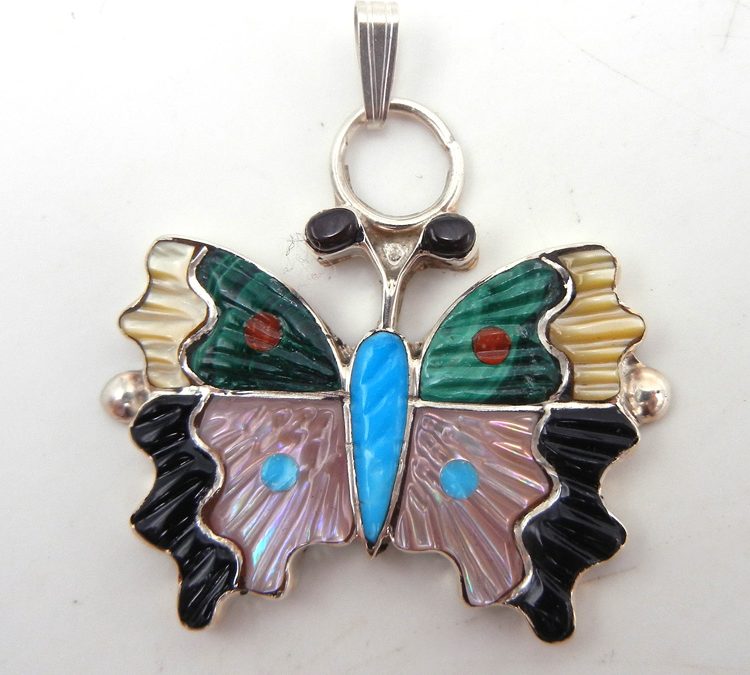Zuni jewelry encompasses a distinctive style backed by ornate processes.
Much like the Navajo, the influences of outsiders helped the Zuni create and innovate their jewelry designs. The Zuni’s jewelry construction and techniques still outshine what Western jewelry designers make today.
Lapidary Artistry
The Ancient Zuni were known for their lapidary skills. Lapidary means to artfully cut and polish stone. The Zuni of today excel in this exceptional style of jewelry making.
Fetishes
Long before the introduction of silversmithing, the Zuni used their lapidary skills to carve fetishes from stone, shell, and coral. Many fetishes were carved out of turquoise, which is still true today.
Fetishes are depictions, much like small statues, of animals and other meaningful Zuni symbols. The Zuni believed that each animal held spiritual powers and influences that could be possessed by those carrying them.
The Zuni people often used these fetishes in ceremonies and other tribal rituals.
Silversmithing’s Influence on Zuni Jewelry
Before the 1800s, Zuni jewelry slowly materialized as fetish and lapidary stonework. In the early 1800s, the Zuni began utilizing copper to form their pieces. It wasn’t until the mid-1800s that what we now know as Zuni jewelry and the techniques used to produce this jewelry came to be.
In the 1870s, Atsidi Chon, a Navajo traveling through Zuni lands, began teaching the Zuni people how to silversmith. This trade had never existed before the Spaniards entered North America.
Initially, silversmithing produced items for everyday use, such as tools and weaponry. As this trade became more widely known, Zuni artists realized they could adapt this technique to make creative jewelry designs.
Soon the Zuni learned how to combine stone lapidary work with silver, and the distinctive Zuni jewelry compositions we see today materialized.
C.G. Wells’ Influence on Zuni Jewelry
Beginning in the early 1900s, a white man would soon befriend the Zuni people of New Mexico and help them innovate their techniques and designs. C.G. Wells was born in North Carolina but moved to Gallup, New Mexico, in the early 1900s. After being hired at a local trading post, he became enthralled with the Zuni people’s culture, language, and art.
In the 1930s, he bought the trading post and saw an opportunity for Zuni jewelry to capture the hearts of the incoming tourists from the Santa Fe Railroad and Route 66.
He gave the Zuni new equipment to work with, encouraged them to use turquoise in their pieces, and provided them with large amounts of precious and semi-precious stones.
These innovations transformed how the Zunis produced their jewelry, and his influences on Zuni jewelry can still be seen today.
Jewelry Styles
It was also during the early 1900s that the Zuni jewelry makers began creating different jewelry styles.
Petit Point
This lapidary technique involves cutting a stone, usually turquoise, into a small, concise shape. These shapes include circles, ovals, squares, rectangles, and pear shapes. These are then clustered to form distinctive designs.
Needle Point
Needle Point is another lapidary technique where the cut stones resemble needle shapes. These needle-shaped stones are then grouped into elegant patterns.
Mosaic Inlay
This technique involves setting lapidary cut stones together, one directly against another, to form a pattern and design. These stones are set within a backing plate to stabilize them. The stones are then polished to create a flat surface.
Channel Inlay
Channel inlay is similar to mosaic inlay, but the cut stones fit precisely into metal channels. These designs look like each stone is surrounded by metal. This differs from mosaic inlay, where each stone is touching the other stones.
Fetish Necklaces
A natural progression for Zuni fetishes came when artisans began stringing these carvings into necklaces.
Holes made in small fetishes prepare them to be strung like beads. Then, shell, turquoise, and other smaller stone beads placed between the fetishes help them remain separated.
Animal Fetish Powers
Fetish carvings are prominent pieces in Zuni jewelry and influential figures in Zuni culture. Each animal carries meaning and powers bestowed upon the wearer. There are many different animal fetishes, but six cardinal guardian animal fetishes exist.
Mountain Lion Fetish: Guardian of the North
The spirit of the mountain lion is associated with leadership, autonomy, intuition, protection, loyalty, and personal power.
Badger Fetish: Guardian of the South
The badger’s spirit conjures boldness and perseverance. He dominates larger animals and possesses tenacity when reaching goals.
Wolf Fetish: Guardian of the East
As a pack animal, the wolf’s spirit encompasses collaboration and teamwork. The wolf also represents teachers and the quest to share knowledge.
Bear Fetish: Guardian of the West
The bear possesses supernatural powers with the ability to heal and protect. His spirit is strong and represents self-knowledge.
Eagle Fetish: Guardian of the Sky
The eagle carries spiritual healing powers and helps those commune with the Great Spirit. The eagle is intuitive, creative, and rises above personal problems.
Mole Fetish: Guardian of the Inner Earth
The mole is a grounding spirit that represents introspection and awareness. The mole is the connection between humans and the underworld of the dead.
Where to Find Zuni Jewelry and Fetishes
Palms Trading Company has a beautiful collection of Zuni jewelry and fetishes. These elegant pieces are bought directly from the artists themselves.
Highlighting the Zuni’s intricate inlaying and lapidary techniques, these pieces offer authentic stones set in silver and gold. Visit our store or shop online today to find the perfect piece or fetish spirit to match your passions.



